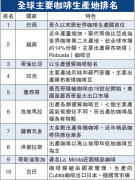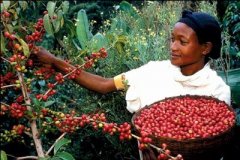Brazilian coffee production Colombian coffee beans coffee net cloth powder coffee latte pull flower mix beans
Brazil produces coffee top all over the world.
The main type of Brazilian coffee is arabico. Most Brazilian coffee has a low sour taste, smooth taste, pure flavor and comfortable entrance. Generally speaking, Brazilian coffee gives people a lively and lively feeling, and many mixed coffee beans or Italian coffee will use Brazilian coffee beans as the bottom.
Brazil is the world's largest coffee producer, with 17 of the 21 states producing coffee, four of which produce the largest, accounting for 98% of the country's total output. Minas Brazil is one of the major coffee producing areas, accounting for about 50% of Brazilian production.
Colombia is the third largest coffee producer in the world, famous for its high quality and delicious taste, and is also one of the few coffee products sold in the world. Roasted coffee beans release sweet flavor, taste appropriate concentration, and are often used in high-grade mixed coffee. The main export market of Colombian coffee is the United States, followed by Germany, Japan, France, Belgium and other western countries.
Costa Rica's output is expected to pick up.
There is good news for fans of premium Colombian coffee. The supply of this major Latin American coffee producer is expected to pick up, and coffee production is expected to continue to grow in the coming years. Colombian coffee farmers are expected to return to pre-global financial crisis levels after five years of ramping up their planting plans.
Coffee rust broke out during coffee cultivation in Colombia in 2008, and production continued to fall from 12.6 million bags in 2007 to only 7.7 million bags in 2012. In fact, coffee farmers in Mexico and Central America also face the problem of coffee rust. After years of overcoming production difficulties, Colombian coffee farmers are expected to help ease supply imbalances at a time when Brazilian coffee production is falling, pushing up coffee prices.
At the same time, coffee farmers in Mexico and Central America are preparing to increase production. According to the International Coffee Organization, this region accounts for one-fifth of the world's Arabica coffee production.
Important Notice :
前街咖啡 FrontStreet Coffee has moved to new addredd:
FrontStreet Coffee Address: 315,Donghua East Road,GuangZhou
Tel:020 38364473
- Prev

Global ranking of major coffee producing areas Coffee mesh powder Coffee producing areas Europe and America Coffee text
- Next

The growth process of coffee tree video coffee tree growth cherry coffee extraction price
The coffee tree is an evergreen tree with small white flowers and green flowers that turn red when it is mature. A normal coffee tree can usually grow to 5 to 10 meters high, but for the convenience of harvesting, bean farmers often prune it to less than 2 meters. After flowering, there are many dark green ellipses, and the mature ones change from dark green to bright red.
Related
- What is the standard process for the purpose of coffee cup testing? What is the difference between hand-brewed coffee and cup testing?
- How to use hand-brewed coffee paragon small golden balls? How does cold coffee lock in the aroma of coffee?
- Is American coffee black? What is the difference between American coffee and drip coffee?
- Unexpected! Well-known tea beverage brand Lele Tea will withdraw from the Zhengzhou market!
- Starbucks enters the fashion and beauty industry?! Netizen: Give me an ice American eye cream
- Why can American refills for free? The difference between Americano and American drip pot coffee
- Being chased out of the rain in front of Starbucks?! Store: Sheltering from rain under umbrellas poses a safety hazard
- The white moonlight has changed?! Lucky launches "Big Winter Pear American"
- Hand-brewed coffee three-stage method, high-sweet and universal brewing method to share! What does the high sweet water level of hand-brewed coffee mean?
- What is the difference between raw, refined and full espresso coffee? How to extract espresso and taste good?

